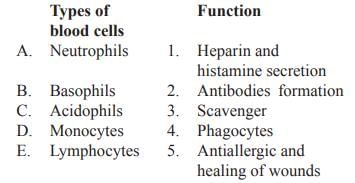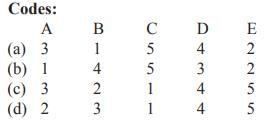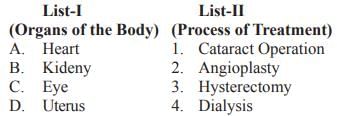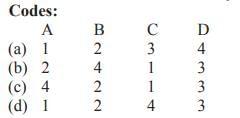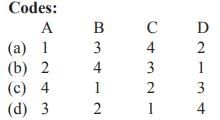Test: Biology - 2 - UPSC MCQ
20 Questions MCQ Test - Test: Biology - 2
Match List-I with List-II and select the correct answer by from the codes given below the lists:
List-I List-II
A. EEG 1. Muscle
B. ECG 2. Eye
C. EOG 3. Brain
D. EMG 4. Heart
A. EEG 1. Muscle
B. ECG 2. Eye
C. EOG 3. Brain
D. EMG 4. Heart
Which of the following diseases are infectious in milch animals?
1. Hand diseases
2. Anthrax
3. Black quarter
4. Cowpox
Q. Select the correct answer from the codes given below:
1. Hand diseases
2. Anthrax
3. Black quarter
4. Cowpox
Q. Select the correct answer from the codes given below:
| 1 Crore+ students have signed up on EduRev. Have you? Download the App |
Consider the following statements:
1. Meningococcal meningitis is transmitted from person to person by mosquito bites.
2. Vomiting and neck pain are two of the symptoms of meningococcal meningitis. Which of the statements given above is/are correct?
1. Meningococcal meningitis is transmitted from person to person by mosquito bites.
2. Vomiting and neck pain are two of the symptoms of meningococcal meningitis. Which of the statements given above is/are correct?
Consider the following statements and select the correct answer from the codes given below:
Assertion (A): If somebody stops taking green vegetables, he will suffer from night blindness.
Reason (R): He will suffer from vitamin A deficiency.
Consider the following statements:
1. Dengue is a protozoan disease transmitted by mosquitos.
2. Retro-orbital pain is not a symptom of dengue.
3. Skin rash and bleeding from nose and gums are some of the symptoms of the dengue.
Q. Which of the statements given above is/are correct?
Consider the following statement about lymph
1. Lymph is another medium of circulation in the human body.
2. Lymph flows in only one direction - from the heart to body tissues.
3. Lymph protects the body by killing the germs drained out of the body tissues with the help of Lymphocytes.
Consider the following statements:
1. ELISA test is employed as the first and most basic test for an individual to detect cancer.
2. Almost 50% human being have Rh+ blood while the remaining have Rh– blood.
Q. Which of the statements given above is/are correct?
Match List-I with List-II and select the correct answer from the codes given below the lists:
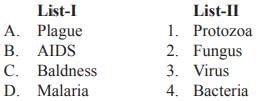
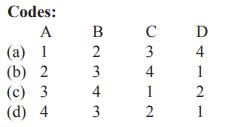
Consider the following statements
Assertion (A): An enzyme is basically a protein which acts like a catalyst in the metabolic reactions of an organism.
Reason (R): The pancreatic juice is basically composed from three enzymes trypsin, amylase and lipase.
Consider the following statements and choose the correct ones.
1. Once the HIV gains a foothold, it can never be eradicated from the body.
2. Many HIV patients, however, can manage the infection with a cocktail of drugs.
3. It is very mutable and infects the respiratory system itself.
Consider the following statements and choose the correct code.
Assertion (A): A true nucleus is absent in E. coli and other prokaryotes.
Reason (R): An undifferentiated, unorganised fibrillar chromosome existsinside the prokaryotic cells.
Consider the following statements and choose the correct code.
Assertion (A): Regeneration in animals is one of the strategies to escape predation.
Reason (R): These strategies include the rearrangement of pre-existing tissue.
Which one of the following animals is correctly matched with its one characteristic and taxon?

Match List-I with List-II and select the correct answer from the codes given below:

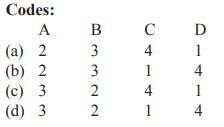
Consider the following statements and choose the correct code.
Assertion (A): Osteoporosis is a reduction in bone mass causing weakness of skeletal bones.
Reason (R): It is caused by excessive resorption of calcium and phosphorus from the bone.
Consider the following statements and the correct ones.
(1) Fish that eradicates the mosquito larva is Gambusia.
(2) The instrument used to measure blood pressure is Autoanalyser.
(3) CT scanning was developed by Godfrey Hounsfield.


